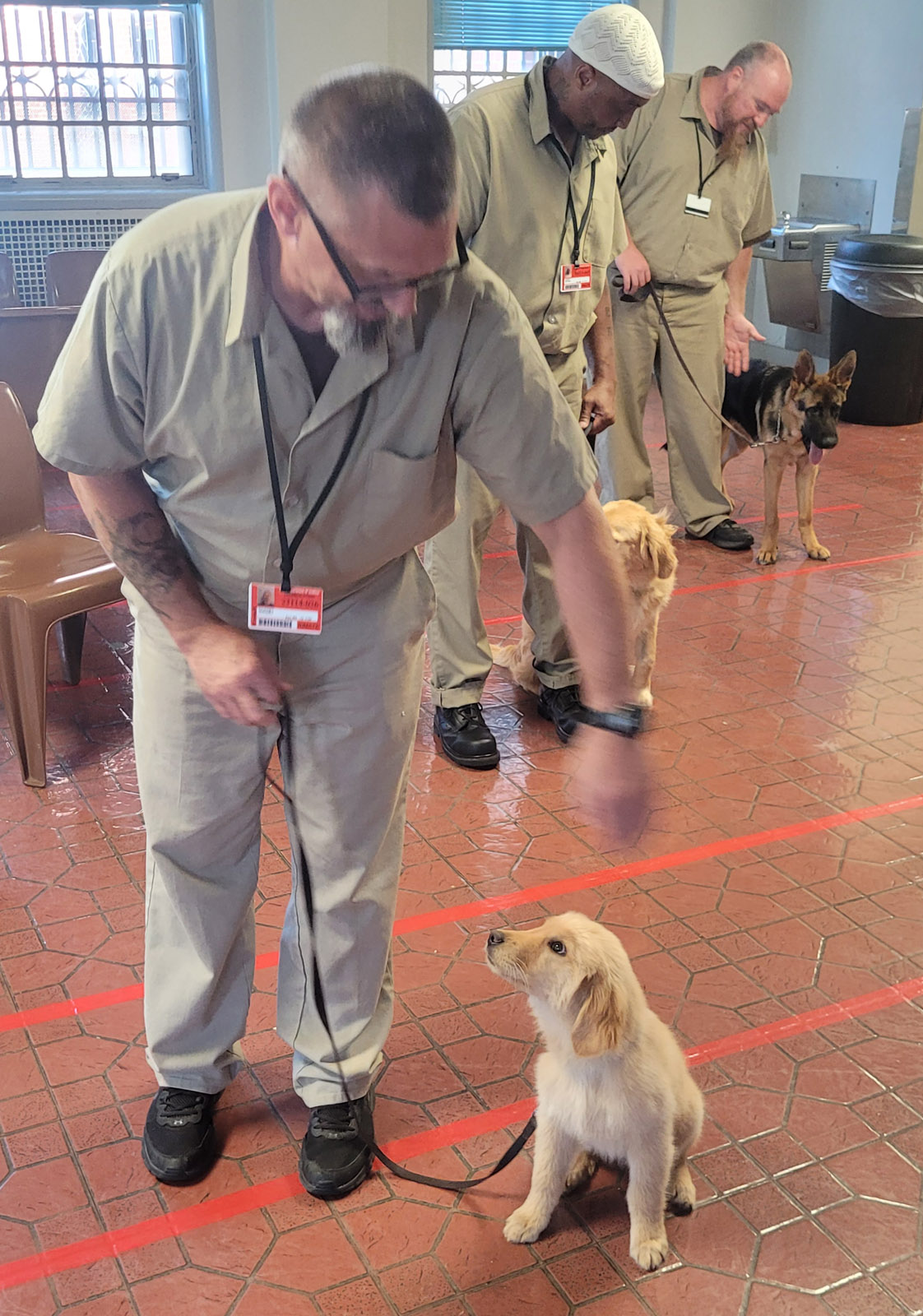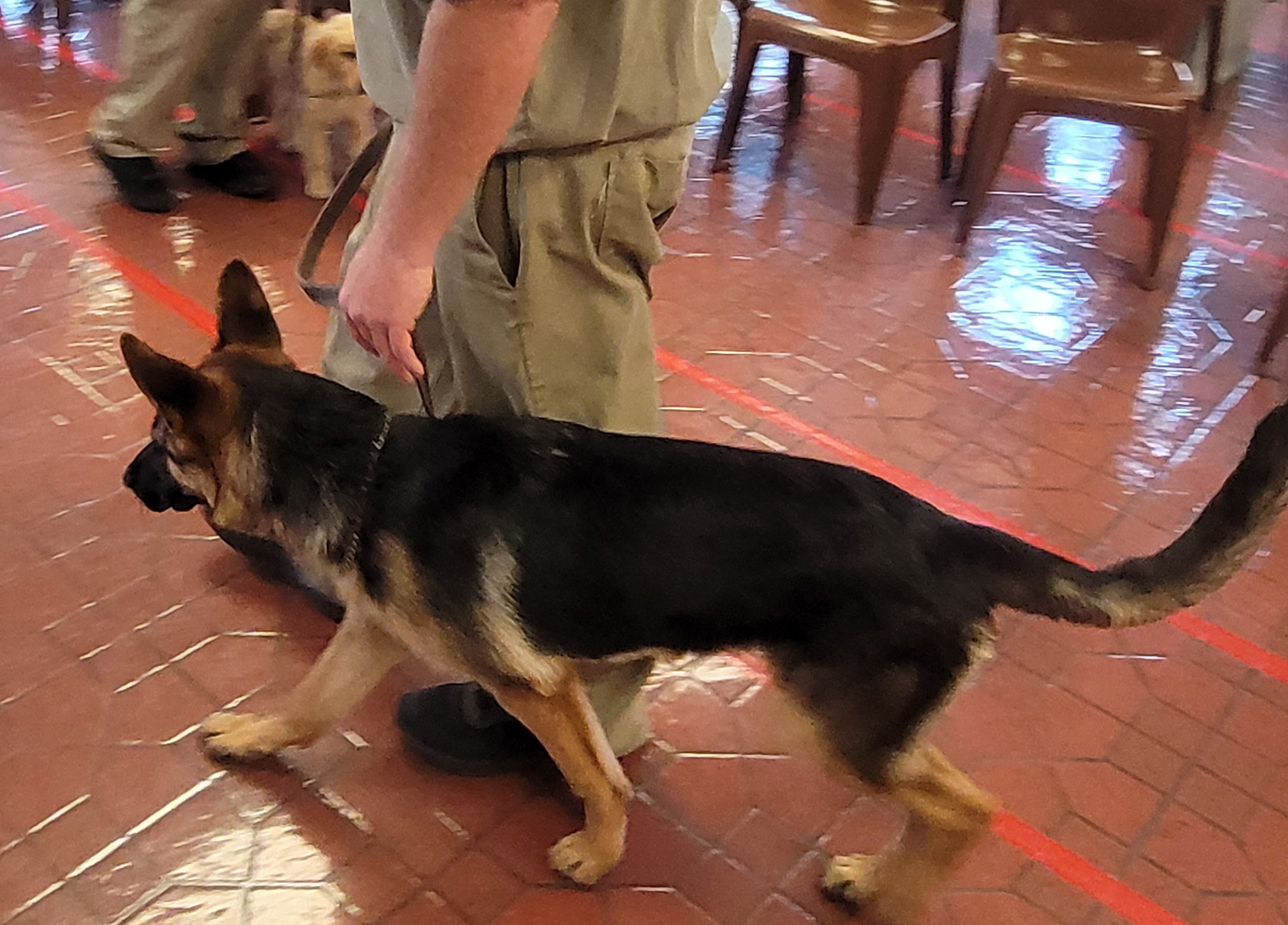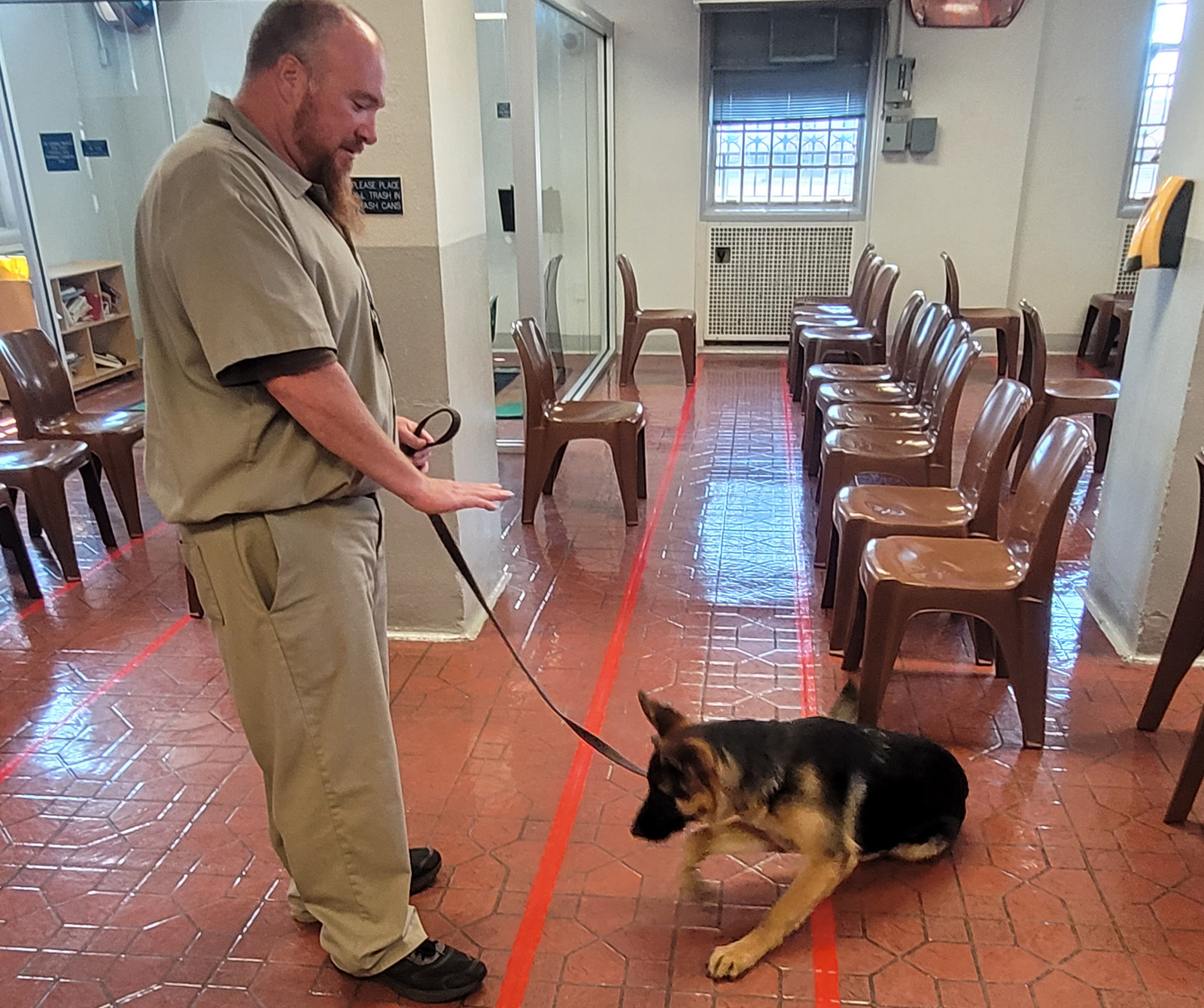Jacob Ryder spends his days training service dogs for people he’ll never meet. He works with one puppy at a time, 24 hours a day, whether it’s sleeping, going to meals or catching some rays outside.
After nine months of that kind of togetherness, it’s hard saying goodbye to a friend, a dog like his current trainee Dohrn, a chill, 5-month-old German shepherd.
The dog will leave to start a new life when his training is finished.
Ryder won’t leave until his federal prison sentence ends on Nov. 20, 2032.
Ryder, serving time on drug-related charges, is one of 980 inmates housed in the U.S. Medical Center for Federal Prisoners in Springfield. He is one of 12 chosen through a competitive process for a full-time job training service dogs through an apprenticeship program, “Paws for a Cause,” recognized by the U.S. Department of Labor.
Once he and the others complete 4,000 hours in the program, they’ll receive a certificate of completion showing they’re job-ready when they leave prison. Two of the 12 inmates aren’t assigned puppies but serve as backup trainers if one of the other 10 has visitors (no dogs allowed), is sick, gets transferred to another facility or is removed from the program for disciplinary reasons.
The “Fed Med,” as it’s known in Springfield, is one of 19 federal prisons that offers the apprenticeship. It was the first in the Bureau of Prison’s North Central Region to adopt it in 2015. Since then, more than 50 inmates have participated in the program, training 199 dogs.
Puppy No. 200 is there now — a 3 ½-month old golden retriever named Mystery — with trainer inmate Jeramey Stuckey. Other institutions have dog training programs but not apprenticeships.
“Training dogs in a federal prison is definitely different,” says Executive Assistant Brandi Ray, a 23-year bureau employee. “But it’s been very well-received and positive for the inmates and the community.”
How a puppy goes to prison
The Fed Med partners with CARES, Inc., a Concordia, Kansas, company focused on training and placing canine assistants. It has programs with four federal and two correctional institutions as well as individual placement agencies, and it accepts applications for dogs to be placed with children and adults with multiple disabilities.
Most of CARES puppies come through its own breeding program of Labrador retrievers and golden retrievers. It also accepts an occasional poodle or German shepherd from a donor or other breeder. CARES’ owner Sarah Holbert says puppies are nurtured by their mothers and socialized by CARES staff and volunteers. At 8 weeks old, temperament- and health-tested, the puppies are given names and ready to begin their training.
That’s how Dohrn, Mystery, Milan and seven other puppies made the journey to Springfield. Zach Copeland, the prison’s head of education, handles the transportation as a certified trainer through CARES and supervises the program.
A job like no other in a place like no other
The Fed Med, looking austere and consequential at Sunshine Street and Kansas Expressway, houses male inmates — from minimum- to maximum security. Some 535 are there for medical, psychiatric or dental care, 445 form the work cadre that maintains the 1930s-era institution. The prison also offers education programs and apprenticeships in a variety of skills including welding and plumbing.
Dog training is one of the Fed Med’s competitive apprenticeships. There’s a waiting list, and not everyone is accepted. Inmates are interviewed at several levels and judged on temperament, patience and their disciplinary record in prison. The Department of Labor also requires they have a GED or high school equivalent.
“Most of them, once they get in the program, they don’t leave,” says the Fed Med’s Brandi Ray.
As prison jobs go, this one’s like no other.
An inmate attends training for six months with supervisor Copeland before getting his first puppy. After that, Copeland says, “For the first two weeks the inmate has a dog, they don’t do training — it’s bonding time. So, when they do start training with the dog, the dog is more accustomed to taking direction from the trainer. Being with the puppy, getting on the floor at their level…potty training them…it takes a lot of effort.”
Trainers earn the same wages as other inmates working in the facility — about 29 cents per hour based on their pay grade; 40 cents per hour for the lead trainer, Copeland says.

But there are perks. Trainers share a housing unit separate from the general prison population. Each man has a private cell big enough for a bed, a locker, dog kennel and enough walk-around space for training the live-in puppy.
And, the inmates say, they’re learning a marketable skill that could help them land a job when they transition back into society.
Michael Kheop, serving time on a conviction related to mail fraud, expects to be released in 2025; Stuckey, convicted on drug possession charges, expects to leave in 2027, and both say they’d consider training dogs for a living or volunteer work on the outside.
A life of regimen and restrictions for puppy and trainer alike
Even living with a puppy, life here is still buttoned-down and prison-strict. It’s up at 5 a.m. to let the pup out to do his business in a restricted yard outside, then feed and water him; launder his soiled linens, bathe him and brush him.
Then it’s training and more training. Classes are one hour, twice a day with supervisor Copeland. They study from the CARES manual, learning how to teach the puppies over 50 commands; gaining respect for an animal whose sense of smell is so acute, it can detect the unique odor a human gives off before having a seizure, and alert the person or get help.
A CARES volunteer liaison routinely visits the inmate trainers to supplement lessons, talk through issues, evaluate each puppy’s progress and handle trips to the vet and groomer. CARES pays for those bills and the dog food; the prison’s education budget pays for extras like dog shampoo and puppy toys.
Day in and day out, trainers work on heel, sit, stay, wait, come. They make sure the dogs are crate-trained, housebroken, go to the bathroom on command and learn to eat out of their bowl. Manners are critical for graduating to a regular household — there’s no barking and no jumping on people.
And there’s no whining in prison. Training boils down to commands, corrective actions and praise — nobody uses treats, says inmate Kheop, who’s training Milan, a spirited 7-month-old golden retriever.
“A dog doesn’t know words, it knows tones,” Kheop says as he draws out a soft, gentle praise for the puppy, ‘Goood dog, Milan… Goood dog.’” A command is assertive and strict. A corrective tone is a growl, just like a pup’s mother uses to keep it in line, he says.
“People would appreciate their pets if they put more effort into training their dogs,” Kheop says. “People get 20-30 percent of pleasure out of their dogs because they’re not trained. They have lower expectations. They really can be excellent companions. It’s not difficult to do. You need to be consistent.”

Dogs get exposure to general population to learn to be calm around others
Around the general prison population, puppies are always leashed. They’re with their trainers and other trainer pairs during meals in a separate dining area, learning to behave in a cafe setting. They walk through the institution together, learning to be calm around other people while obedient to the trainer.
Still, the sight of a puppy walking down the long halls of prison is so unexpected and rare that inmates and staff, alike, have to be taught not to approach until trainer and dog are stopped and ready.
“Puppy time” is three days a week for an hour in the recreation yard at reserved times “to get their wiggles out,” supervisor Copeland says. That’s also training time, when the puppy learns to play unleashed in the yard, and snap back to his trainer’s side on command.
“Every bit of every day is training,” Ryder says. “It’s a continual learning process. “I’ve been in it 2 ½ years and I’m still learning new things and how to deal with different situations.”
The only time trainer and pup are not together is in food prep areas or when the inmate has visitors. That’s when the two trainer assistants fill in.
And so the day goes, with one more pit stop outside before it’s lights-out for puppy at 8 p.m.
In Ryder’s world, that’s a good day. “You can’t be sad with a little puppy in your life.”
Prison life compatible with puppy training
Training puppies in a prison makes sense, says CARES owner Sarah Holbert. “When a puppy goes into a facility, especially the Fed Med, it’s going to go with one person, 24/7. That puppy is that handler’s focus.
“It’s a win-win. The guys are very diligent. If the puppy has an infection or is teething, they know the nuances. If there is an issue, they know it right away… Those guys take care of all of that,” she adds.
Once a puppy graduates, supervisor Copeland returns it to CARES for socialization, follow-up training and eventual assignment. Then, he picks up one or two new training-ready pups for the return trip to Springfield.
Puppies that begin their training at the Fed Med may grow up and go on to serve a person with mobility support or retrieve items, alert its human companion about an impending seizure, provide comfort to a person with PTSD or trauma; or serve as therapy dogs.

Inmates benefit from the program
Therapy goes both ways.
“Once a month we visit the (prison) medical wards and visit inmates who are bedridden or on hospice care,” Stuckey explains. “To see the smile on their faces… They tell you it just makes their day.” A lot of inmates have been in there a long time, Ryder adds. “Just for the ability to pet a dog means a lot.”
For Stuckey, it’s personal. “I feel blessed to be in the dog program. I’m doing something productive and doing something for someone on the outside. It gives me a sense of pride. It’s definitely changed me. Before, I always thought of myself and didn’t really care about what other people needed. Taking care of dogs, hearing how a dog trained two years ago may have saved the life of a child… that’s kind of hard to do that in a prison.”
As their supervisor watching inmates go through the program, Copeland sees a difference, too. The men tend to deal with staff a lot better, he says. They avoid petty confrontations. After success in the puppy program, he says, some inmates who weren’t willing to enroll in other training opportunities in the prison are more open to try new things.
Science seems to bear out the positive effects of petting a dog. Nancy Gee is a professor of psychiatry and director of the Center for Human-Animal Interaction at Virginia Commonwealth University. She told National Public Radio about growing evidence that levels of the stress hormone cortisol drop in people after just five to 20 minutes spent interacting with dogs — even someone else’s. She said scientists also see increases in oxytocin, the feel-good kind of bonding hormone, in the humans and the dogs.
Graduation and goodbye
The four-legged graduates have more training after they leave the Fed Med and return to CARES. They’re placed in a foster home to get used to life outside an institution: living with a family in a house, going for walks, experiencing traffic and noise. Experiencing cats. CARES follows that with advanced training focused on each dog’s ultimate service assignment.
The inmate trainers never know where their dogs are placed, but CARES sends them a certificate with a photo of their dog and its new job assignment.
They hear success stories from CARES volunteers. Inmate Michael Kheop learned about a 6-year-old girl with diabetes who was in the first hour of training with her newly assigned dog. Out of nowhere, the dog gave the alert he was trained to give that the girl was about to have a seizure. Kheop adds, “It was one of the dogs we had trained.”
“It’s bittersweet,” Ryder adds. “You’ve put a lot of love and effort into your dog’s training, so sometimes it’s hard to see our friends leave, but you know he’s going to do great things for someone with the skills you’ve taught him.”
And that, he says, helps take away the sting of goodbye.
Editor’s note: Freelancer Kathleen O’Dell serves on the volunteer Community Relations Board of the U.S. Medical Center for Federal Prisoners. She conducted the interview in the visiting room inside the prison.


